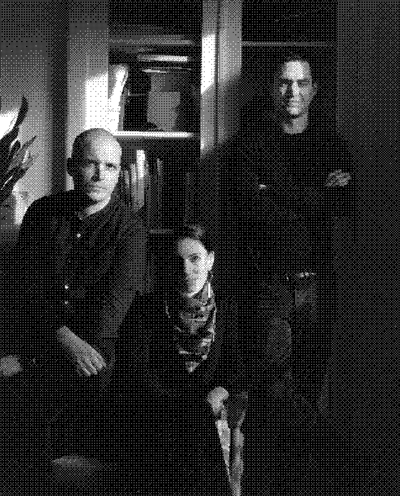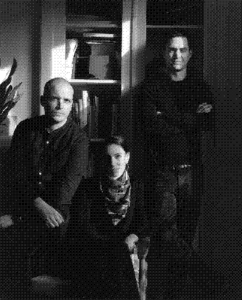References Development Strategy Advice Management Prospective Creativity Clients Communication Process Prospection Work culture Competition Presentation Design Typography Agents Advertising Ai Finance Architecture Investment Education Cgi Trend Fashion Recruitment Graphic design Nft Music Marketing Photography Sound design Research Blockchain Sustainability Crypto Technology Metaverse
18 excerpts on the topic “Presentation”
[…] Now, we’ve reached a point where we also see ourselves as consultants to our clients. It’s not just about delivering the work, it’s about guiding them towards the best solution. We take a more strategic approach, challenging initial ideas when necessary. Going back to our presentations, we now structure them to include more conceptual direction for our clients, helping them see the bigger picture. […]
[…] Very often, the client is worried about handing over their project to creatives, especially when they talk a lot, like me. The first step is about reassuring them and making them understand that their needs come first—as long as they are not in direct contradiction with my process. Once that trust is established, then you can start introducing strong, creative ideas. Sometimes, it’s not necessarily about compromising, but simply deciding that maybe this or that idea isn’t the best suited for the brief. I feel infinitely freer and more capable of offering things that I find truly relevant, particularly today, compared to a few years ago. […]
[…] One thing I’ve always learned is what I would call the “performance” of design: the performance of conversation, of being in a room with someone and talking through an idea. If I could get someone on the phone or in front of me, I could usually do the song and dance that would land us the job. Whether or not I actually knew how to pull it off at that exact moment was another story—but I knew I could figure it out. […]
[…] On a more practical level, I think one of the most important parts of our strategy as a studio has been really refining how we communicate. Understanding how we work with clients—not just creatively, but operationally. Thinking about how we function as a creative team and as a production team. Making sure we’re not just coming up with good ideas, but actually executing them in a way that yields the best results. That includes things like: “Who are we presenting to? How are we presenting to them? What’s the format, the tone, the setup?” All of that—those little strategy decisions—can ultimately make or break a project. […]
[…] What’s been so great about Brat is that it has given us this new confidence and made us feel more empowered to present bold, radical ideas—ideas we might have been more hesitant about before. We weren’t always taking those creative liberties because we were still operating from a service mentality. Like, “How can I make this client’s idea the best it can be?” I used to think about design primarily as a service. But now, more and more, we’re thinking about design as a product. […]
[…] One thing that stands out in our work is how we present to clients. We don’t show finished designs but instead share in-progress work like interactive mockups the client can try. This helps build trust because clients see the work developing as we go. I believe this very personalized approach to each client makes us different from other creatives and is why clients often recommend us. […]
[…] SE
You persuade and you entertain and you excite. Those are the tools that you use for presentations. And none of these apps do that – not even Figma, which is made for designers. Or you have a really good designer who can create components that your producer can maybe reuse, but you still need design skills. Dekks was a step towards pre-composed modules and blocks that you can design with your own content. Most of the time your presentations repeat. You need the same templates and modules. You just stitch them together in a different way. […]
You persuade and you entertain and you excite. Those are the tools that you use for presentations. And none of these apps do that – not even Figma, which is made for designers. Or you have a really good designer who can create components that your producer can maybe reuse, but you still need design skills. Dekks was a step towards pre-composed modules and blocks that you can design with your own content. Most of the time your presentations repeat. You need the same templates and modules. You just stitch them together in a different way. […]
[…] AR
I think these days presentations are not linear at all. I find when presenting ideas that you do end up moving around and having that ability to kind of almost edit in real time, you’re presenting something but you can edit the presentation in real time and you can move things in and jump around. It’s more of a holistic experience rather than a linear experience. […]
I think these days presentations are not linear at all. I find when presenting ideas that you do end up moving around and having that ability to kind of almost edit in real time, you’re presenting something but you can edit the presentation in real time and you can move things in and jump around. It’s more of a holistic experience rather than a linear experience. […]
[…] SE
It’s also about just simply almost un-designing presentations, while still making them look and feel good. A lot of designers over-design their presentation and their design becomes more of a thing than the actual ideas that they present. At the end of the day, the design really should just elevate the ideas that you have to show for your clients. That’s what we’re trying to solve. […]
It’s also about just simply almost un-designing presentations, while still making them look and feel good. A lot of designers over-design their presentation and their design becomes more of a thing than the actual ideas that they present. At the end of the day, the design really should just elevate the ideas that you have to show for your clients. That’s what we’re trying to solve. […]
[…] Post-rationalisation. I still use it now. When at the start of a project I don’t have any precise ideas, I search, I experiment, I run a few intuitive tests, and once I’ve got visuals that make sense, I formulate the idea. When presenting the visual to the client I link what I have produced to the subsequent idea. It sounds like a con job, as if we were snowing the client but intuition rules because intuition makes sense. There is obviously a reason for spontaneously choosing this or that artistic or graphic solution. […]
[…] DL
I am responsible for new business and if there’s a new client, I want to meet them. So my design approach – and it’s a big part of the quality of the project – is reading the room, making a connection with people: who are they? What are they concerned about? What are they inspired by? And who in our studio can react in a way that is relevant for these people? How do we work with them in a way that they keep feeding the inspiration, the creation and so we’re not afraid that it might go wrong? I really try to tune in… My part is more the tuning in on the human level. […]
I am responsible for new business and if there’s a new client, I want to meet them. So my design approach – and it’s a big part of the quality of the project – is reading the room, making a connection with people: who are they? What are they concerned about? What are they inspired by? And who in our studio can react in a way that is relevant for these people? How do we work with them in a way that they keep feeding the inspiration, the creation and so we’re not afraid that it might go wrong? I really try to tune in… My part is more the tuning in on the human level. […]
[…] JF
if you can sum up an idea and send it to a client, then you don’t need to present it in person (…) your communication skills should be good enough to be able to clearly communicate an idea in a document. […]
if you can sum up an idea and send it to a client, then you don’t need to present it in person (…) your communication skills should be good enough to be able to clearly communicate an idea in a document. […]
[…] Presenting ideas has to be as straight and direct as possible. […]
[…] You have to build trust with clients and build a conversation where they understand your creative thinking and your problem solving. They must be willing to take the risk. And you have to show them why it’s important to take risks. […]
[…] I tell my students that no matter how good they are there’s always going to be someone less competent and less gifted than them but better equipped at selling themselves (…) then let’s make sure competent people also manage to sell work of quality. […]
[…] In my profession you can never think for one second that people comprehend what you’re doing. They’re incapable of telling the difference between a good logo and a bad logo, a good font and a bad font. A rule is to only show options you’re proud of, so you’ll be pleased no matter what they choose. […]
[…] Basically, the client knows best how his brand is working and how it should communicate. But it’s always the strategic idea, or the dogmatic thinking behind the design first. It’s very important for people to follow the reasoning behind something which may be disruptive, because otherwise, as I’ve said before, it’s just “looking good” or “weird”. […]
[…] In terms of process, typically, there is some point when there is a presentation and they want to see a concept. However, before that, in our sketching process, we stop halfway and we invite the clients to see our sketches. (…) We will make a selection but there could be tens of things that we will share.
With the client we then have a discussion on what works, what doesn’t work, what they feel is right. It can be very confrontational because they see a lot and not everybody knows how to deal with image. (…) From their reaction, we get a better understanding of where we have to go. (…) That initial process, we call it “the kitchen review”. […]
With the client we then have a discussion on what works, what doesn’t work, what they feel is right. It can be very confrontational because they see a lot and not everybody knows how to deal with image. (…) From their reaction, we get a better understanding of where we have to go. (…) That initial process, we call it “the kitchen review”. […]

